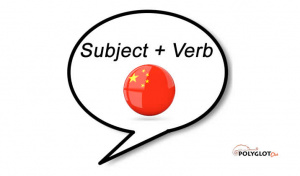Difference between revisions of "Language/Mandarin-chinese/Grammar/Basic-structure-of-a-sentence"
< Language | Mandarin-chinese | Grammar
Jump to navigation
Jump to search
| Line 86: | Line 86: | ||
!Subject | !Subject | ||
!Verb | !Verb | ||
! | !Object | ||
!Pinyin | !Pinyin | ||
!Translation | !Translation | ||
Revision as of 14:19, 18 November 2018
In its most basic form, the order of words in Chinese is quite similar to the order of words in English.
However, do not expect to have a completely similar order, especially when you try more complex sentences.
subject-predicate
The most basic word order in Chinese is:
Subject + verb
You can create very simple sentences with only two words.
Examples
| Subject | Verb | Pinyin | Translation |
|---|---|---|---|
| 他 | 笑。 | Tā xiào. | He's laughing. |
| 你 | 吃。 | Nǐ chī. | You eat. |
| 我 | 讀。/读。 | Wǒ dú. | I am reading. |
| 你 | 看。 | Nǐ kàn. | You look. |
| 你 | 說。/说。 | Nǐ shuō. | You speak. |
| 我 | 去。 | Wǒ qù. | I leave. |
| 你 | 滾!/滚! | Nǐ gǔn | Leave here |
| 孩子 | 哭。 | Háizi kū. | The children are crying. |
| 谁 | 要 學?/要 学? | Shuí yào xué? | Who wants to study? |
| 誰/谁 | 想 做? | Shuí xiǎng zuò? | Who wants to do it? |
Subject, verb and object
A simple sentence is often composed of an object and follows this structure:
Subject + Verb + Object
It's exactly like in English, a word order designated by the name SVO.
You can express a whole range of information with this very simple structure.
Examples
| Subject | Verb | Object | Pinyin | Translation |
|---|---|---|---|---|
| 我 | 吃 | 肉。 | Wǒ chī ròu. | I eat meat. |
| 我 | 去 | 學校。/学校。 | Wǒ qù xuéxiào. | I go to school. |
| 你 | 喝 | 汤。 | Nǐ hē tāng. | You drink soup. |
| 我們/我们 | 要 買/要 买 | 電脑。/电脑。 | Wǒmen yāomǎi diànnǎo. | We will buy a computer. |
| 他 | 說/说 | 中文。 | Tā shuō Zhōngwén. | He speaks Chinese. |
| 我 | 喜歡/喜欢 | 那 個 小 孩子。/那 个 小 孩子。 | Wǒ xǐhuān nàgè xiǎo háizi. | I like this child. |
| 我 | 想 吃 | 中國 菜。/中国 菜。 | Wǒ xiǎng chī Zhōngguó cài. | I want to eat Chinese. |
| 我 | 愛/爱 | 你 和 爸爸。 | Wǒ ài nǐ hé bàba. | I love you and dad. |
| 你 | 想 吃 | 什麽 菜?/什么 菜? | Nǐ xiǎng chī shénme cài? | Do you want to eat which dish? |
| 你 | 要 做 | 什麽?/什么? | Nǐ yào zuò shénme? | What do you want to do? |
